In trying to understand what constitutes a חזקה, presumptive ownership, the Gemara on Bava Batra 28b attempts a comparison to the goring ox. Just as goring three times in succession creates a presumption of a forewarned animal, so too eating three fruits from three harvests, one day after the other, should create a presumption, in this case of ownership, a chazaka. The Gemara rejects this idea:
“Just as with a forewarned ox, at the time when it has this goring, it does not have that goring, [as each act of goring occurs at a separate time,] here too at the time when this fruit is here, that fruit is not here.” (Bava Batra 28b)
But are there fruits that only come into being after other fruits are eaten? The rabbis need to find a fruit that becomes ripe almost immediately, so as to fit the comparison. What is this fruit? The fruit of the caper bush, the צלף.
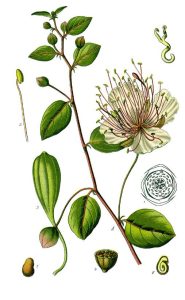
Otto Wilhelm Thomé (1840-1925), Public domain, via Wikimedia Commons
The caper is found all over Israel. In the spring they bloom everywhere, filling empty lots or the side of the road with beauty. Not many people cultivate caper bushes today, they just grow wild and some even think of them as weeds. But in Biblical and Mishnaic times they were an important part of life. This is because, as the Gemara points out, they ripen quickly and at different times, so they can be an important source of food over many months. One interpretation of our Gemara is that the fruit ripens very quickly, seemingly appearing out of nowhere in one day:
“Rabban Gamliel sat and interpreted homiletically: In the future trees will produce fruits every day, as it is stated: “And it shall bring forth branches and bear fruit” (Ezekiel 17:23); just as a branch grows every day, so too, fruit will be produced every day. A certain student scoffed at him and said: Isn’t it written: There is nothing new under the sun? He said to him: Come and I will show you an example of this in this world. He went outside and showed him a caper bush,” (Shabbat 30b)
Tosafot explains that while figs also ripen over a long period of time, you can see the unripe figs for quite a long time before they are edible. Caper fruits are almost invisible until they are ripe so they are considered “not here.”
Another interpretation is that the caper bush produces different types of food and they ripen at different times. The Mishnah in Maasrot enumerates the caper parts:
“Rabbi Eliezer says: as for the caper bush, tithes must be given from the shoots (תמרות), the berries (אביונות) and the blossoms (קפרס). Rabbi Akiba says: only the berries are tithed since they [alone] count as fruit.” (Mishnah Maaserot 4:6)
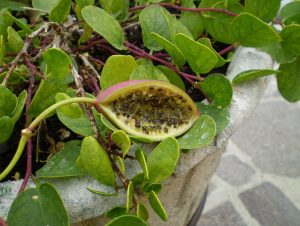
Caper Berry
Clematis, CC BY-SA 3.0 <http://creativecommons.org/licenses/by-sa/3.0/>, via Wikimedia Commons
The Talmud in Berakhot (36a) discusses what blessing is said over the caper: העץ because it is fruit from a the tree, or האדמה, because it is more like a bush, growing from the ground. All these sources give us a sense that all the components were used for food: the bud (the part we eat today), the flower, the leaves and the berries. Once all the edible parts were gone, the caper was still useful. The thorny bush keeps out invaders and later the dried branches can be used for fuel.
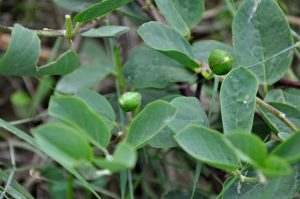
Caper Buds
Lazaregagnidze, CC BY-SA 3.0 <https://creativecommons.org/licenses/by-sa/3.0>, via Wikimedia Commons
Like today, in ancient times the caper buds were pickled before they were eaten. The names of two of our Sages, Elazar the Kappar and Bar Kappara, have the caper in their names (the Hebrew word for the plant isצלף but the word for the bud is קפרסcapers.) One suggestion is that at least Rabbi Elazar (who may have been the father of Bar Kappara) was a caper pickler, giving him his title. In the Golan a stone lintel was discovered that tells us that this was the study house of Rabbi Elazar HaKappar:
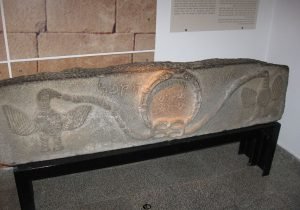
Ori~, Attribution, via Wikimedia Commons
The hardy caper is compared to the Jewish people in that they are both called עז which I think best translates to chutzpadik.
“Rabbi Shimon ben Lakish said: There are three impudent ones: The Jewish people among the nations; the dog among animals; and the rooster among birds. . .And some say: Also the caper bush among trees.” (Betzah 25b)
A caper will grow just about anywhere, under harsh conditions, and return even if it has been uprooted. The parallels to the Jews are obvious. The most famous place to see this tenacity is at the Western Wall. The plants growing out of the stones are none other than caper bushes.
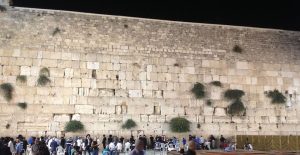
Bo Basil, CC BY-SA 4.0 <https://creativecommons.org/licenses/by-sa/4.0>, via Wikimedia Commons
When Noga HaReuveni decided to create the Biblical and Mishnaic nature reserve called Neot Kedumim, he was also somewhat chutzpadik, which can be another word for visionary. He chose a barren piece of land and envisioned a lake, groves, flocks and all sorts of components that would bring ancient flora and fauna alive. It seems fitting that he chose for the symbol of the park the caper flower, a sign of his and the Jewish people’s tenaciousness.
The thorns of the caper make it a useful natural fence. The story below stars a caper bush:
“The Sages taught: There was an incident with a pious man in which a breach was made in his field, and he decided to fence it in. And then he remembered that it was Shabbat. And that pious man refrained from fixing the fence [forever because he had thought about fixing it on Shabbat.] And a miracle was done for him, and a caper bush grew there and from it he received his livelihood and the livelihood of the members of his household.” (Shabbat 150b)
An interesting midrashic approach connects Tzelofchad (whose name resembles the tzalaf), the father of the famous daughters in the desert who request land from Moses, with this story. The daughters emphasize that Tzelophchad did not die because he followed Korach’s rebellion but rather:
“’Our father died in the wilderness. . . but he died for his own sin; and he has left no sons’” (Bamidbar 27:3)
What was Tzelofchad’s sin? Rabbi Akiva (Shabbat 96b) says that he was the man who gathered wood on Shabbat and was stoned. The Petach Einayim (the Hida, Rabbi Yosef Hayim Azulai, 18th century Israel) gives a Kabbalistic explanation from the ARI to the story of the righteous man with the fence, connecting him to Tzelofchad and his sin. He says that the man was a reincarnation of Tzelofchad, who was repenting for violating Shabbat by vowing to never repair the fence. In return, he was rewarded with one caper, a צלף (א)חד which provided him with his livelihood!
The next time you go for a walk in Israeli fields, keep your eyes open for the beautiful caper.
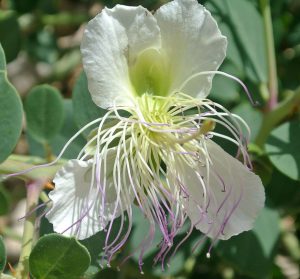
Wilson44691, CC0, via Wikimedia Commons










